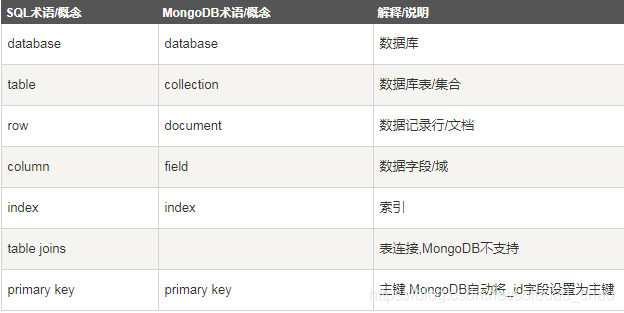MongoDB笔记
MonggoDB学习
MongoDB 是一个基于分布式文件存储的数据库。由 C++ 语言编写。旨在为 WEB 应用提供可扩展的高性能数据存储解决方案。
MongoDB 是一个介于关系数据库和非关系数据库之间的产品,是非关系数据库当中功能最丰富,最像关系数据库的。
基本命令
成功启动MongoDB后,再打开一个命令行窗口输入mongo,就可以进行数据库的一些操作。
输入help可以看到基本操作命令:
show dbs:显示数据库列表show collections:显示当前数据库中的集合(类似关系数据库中的表)show users:显示用户
use <db name>:切换当前数据库,这和MS-SQL里面的意思一样db.help():显示数据库操作命令,里面有很多的命令db.foo.help():显示集合操作命令,同样有很多的命令,foo指的是当前数据库下,一个叫foo的集合,并非真正意义上的命令db.foo.find():对于当前数据库中的foo集合进行数据查找(由于没有条件,会列出所有数据)db.foo.find( { a : 1 } ):对于当前数据库中的foo集合进行查找,条件是数据中有一个属性叫a,且a的值为1
MongoDB没有创建数据库的命令,但有类似的命令。
如:如果你想创建一个“myTest”的数据库,先运行use myTest命令,之后就做一些操作(如:db.createCollection(‘user’)),这样就可以创建一个名叫“myTest”的数据库。
数据库常用命令
1、Help查看命令提示
help
db.help();
db.yourColl.help();
db.youColl.find().help();
rs.help();
2、切换/创建数据库
use yourDB; 当创建一个集合(table)的时候会自动创建当前数据库
3、查询所有数据库
show dbs;
4、删除当前使用数据库
db.dropDatabase();
5、从指定主机上克隆数据库
db.cloneDatabase(“127.0.0.1”); 将指定机器上的数据库的数据克隆到当前数据库
6、从指定的机器上复制指定数据库数据到某个数据库
db.copyDatabase("mydb", "temp", "127.0.0.1");将本机的mydb的数据复制到temp数据库中
7、修复当前数据库
db.repairDatabase();
8、查看当前使用的数据库
db.getName();
db; db和getName方法是一样的效果,都可以查询当前使用的数据库
9、显示当前db状态
db.stats();
10、当前db版本
db.version();
11、查看当前db的链接机器地址
db.getMongo();
Collection聚集集合
1、创建一个聚集集合(table)
db.createCollection(“collName”, {size: 20, capped: 5, max: 100});
2、得到指定名称的聚集集合(table)
db.getCollection("account");
3、得到当前db的所有聚集集合
db.getCollectionNames();
4、显示当前db所有聚集索引的状态
db.printCollectionStats();
用户相关
1、添加一个用户
db.addUser("name");
db.addUser("userName", "pwd123", true); 添加用户、设置密码、是否只读
2、数据库认证、安全模式
db.auth("userName", "123123");
3、显示当前所有用户
show users;
4、删除用户
db.removeUser("userName");
其他
1、查询之前的错误信息db.getPrevError();
2、清除错误记录db.resetError();
查看聚集集合基本信息
1、查看帮助 db.yourColl.help();
2、查询当前集合的数据条数 db.yourColl.count();
3、查看数据空间大小 db.userInfo.dataSize();
4、得到当前聚集集合所在的db db.userInfo.getDB();
5、得到当前聚集的状态 db.userInfo.stats();
6、得到聚集集合总大小 db.userInfo.totalSize();
7、聚集集合储存空间大小 db.userInfo.storageSize();
8、Shard版本信息 db.userInfo.getShardVersion()
9、聚集集合重命名 db.userInfo.renameCollection("users"); 将userInfo重命名为users
10、删除当前聚集集合 db.userInfo.drop();
聚集集合查询
1、查询所有记录db.userInfo.find();
相当于:select* from userInfo;
默认每页显示20条记录,当显示不下的情况下,可以用it迭代命令查询下一页数据。注意:键入it命令不能带“;”
但是你可以设置每页显示数据的大小,用DBQuery.shellBatchSize= 50;这样每页就显示50条记录了。
2、查询去掉后的当前聚集集合中的某列的重复数据db.userInfo.distinct("name");
会过滤掉name中的相同数据
相当于:select distict name from userInfo;
3、查询age = 22的记录db.userInfo.find({"age": 22});
相当于: select * from userInfo where age = 22;
4、查询age > 22的记录db.userInfo.find({age: {$gt: 22}});
相当于:select * from userInfo where age >22;
5、查询age < 22的记录db.userInfo.find({age: {$lt: 22}});
相当于:select * from userInfo where age <22;
6、查询age >= 25的记录db.userInfo.find({age: {$gte: 25}});
相当于:select * from userInfo where age >= 25;
7、查询age <= 25的记录db.userInfo.find({age: {$lte: 25}});
8、查询age >= 23 并且 age <= 26db.userInfo.find({age: {$gte: 23, $lte: 26}});
9、查询name中包含 mongo的数据db.userInfo.find({name: /mongo/});
//相当于%%
select * from userInfo where name like ‘%mongo%’;
10、查询name中以mongo开头的db.userInfo.find({name: /^mongo/});
select * from userInfo where name like ‘mongo%’;
11、查询指定列name、age数据db.userInfo.find({}, {name: 1, age: 1});
相当于:select name, age from userInfo;
当然name也可以用true或false,当用ture的情况下河name:1效果一样,如果用false就是排除name,显示name以外的列信息。
12、查询指定列name、age数据, age > 25db.userInfo.find({age: {$gt: 25}}, {name: 1, age: 1});
相当于:select name, age from userInfo where age >25;
13、按照年龄排序
升序:db.userInfo.find().sort({age: 1});
降序:db.userInfo.find().sort({age: -1});
14、查询name = zhangsan, age = 22的数据db.userInfo.find({name: 'zhangsan', age: 22});
相当于:select * from userInfo where name = ‘zhangsan’ and age = ‘22’;
15、查询前5条数据db.userInfo.find().limit(5);
相当于:selecttop 5 * from userInfo;
16、查询10条以后的数据db.userInfo.find().skip(10);
相当于:select * from userInfo where id not in (
selecttop 10 * from userInfo
);
17、查询在5-10之间的数据db.userInfo.find().limit(10).skip(5);
可用于分页,limit是pageSize,skip是第几页*pageSize
18、or与 查询db.userInfo.find({$or: [{age: 22}, {age: 25}]});
相当于:select * from userInfo where age = 22 or age = 25;
19、查询第一条数据db.userInfo.findOne();
相当于:selecttop 1 * from userInfo;
db.userInfo.find().limit(1);
20、查询某个结果集的记录条数db.userInfo.find({age: {$gte: 25}}).count();
相当于:select count(*) from userInfo where age >= 20;
21、按照某列进行排序db.userInfo.find({sex: {$exists: true}}).count();
相当于:select count(sex) from userInfo;
索引
1、创建索引db.userInfo.ensureIndex({name: 1});db.userInfo.ensureIndex({name: 1, ts: -1});
2、查询当前聚集集合所有索引db.userInfo.getIndexes();
3、查看总索引记录大小db.userInfo.totalIndexSize();
4、读取当前集合的所有index信息db.users.reIndex();
5、删除指定索引db.users.dropIndex("name_1");
6、删除所有索引索引db.users.dropIndexes();
修改、添加、删除集合数据
1、添加db.users.save({name: ‘zhangsan’, age: 25, sex: true});
添加的数据的数据列,没有固定,根据添加的数据为准
2、修改db.users.update({age: 25}, {$set: {name: 'changeName'}}, false, true);
相当于:update users set name = ‘changeName’ where age = 25;
db.users.update({name: 'Lisi'}, {$inc: {age: 50}}, false, true);
相当于:update users set age = age + 50 where name = ‘Lisi’;
db.users.update({name: 'Lisi'}, {$inc: {age: 50}, $set: {name: 'hoho'}}, false, true);
相当于:update users set age = age + 50, name = ‘hoho’ where name = ‘Lisi’;
3、删除db.users.remove({age: 132});
4、查询修改删除
db.users.findAndModify({
query: {age: {$gte: 25}},
sort: {age: -1},
update: {$set: {name: 'a2'}, $inc: {age: 2}},
remove: true
})db.runCommand({ findandmodify : "users",
query: {age: {$gte: 25}},
sort: {age: -1},
update: {$set: {name: 'a2'}, $inc: {age: 2}},
remove: true
})update 或 remove 其中一个是必须的参数; 其他参数可选。
参数
详解
默认值
query
查询过滤条件
{}
sort
如果多个文档符合查询过滤条件,将以该参数指定的排列方式选择出排在首位的对象,该对象将被操作
{}
remove
若为true,被选中对象将在返回前被删除
N/A
update
一个 修改器对象
N/A
new
若为true,将返回修改后的对象而不是原始对象。在删除操作中,该参数被忽略。
false
fields
参见Retrieving a Subset of Fields (1.5.0+)
All fields
upsert
创建新对象若查询结果为空。 示例 (1.5.4+)
false
语句块操作
1、简单Hello World
print(“Hello World!”);
这种写法调用了print函数,和直接写入"Hello World!"的效果是一样的;
2、将一个对象转换成json
tojson(new Object());
tojson(new Object(‘a’));
3、循环添加数据
for (var i = 0; i < 30; i++) {
… db.users.save({name: “u_” + i, age: 22 + i, sex: i % 2});
… };
这样就循环添加了30条数据,同样也可以省略括号的写法
for (var i = 0; i < 30; i++) db.users.save({name: “u_” + i, age: 22 + i, sex: i % 2});
也是可以的,当你用db.users.find()查询的时候,显示多条数据而无法一页显示的情况下,可以用it查看下一页的信息;
4、find 游标查询
var cursor = db.users.find();
while (cursor.hasNext()) {
printjson(cursor.next());
}
这样就查询所有的users信息,同样可以这样写
var cursor = db.users.find();
while (cursor.hasNext()) { printjson(cursor.next); }
同样可以省略{}号
5、forEach迭代循环
db.users.find().forEach(printjson);
forEach中必须传递一个函数来处理每条迭代的数据信息
6、将find游标当数组处理
var cursor = db.users.find();
cursor[4];
取得下标索引为4的那条数据
既然可以当做数组处理,那么就可以获得它的长度:cursor.length();或者cursor.count();
那样我们也可以用循环显示数据
for (var i = 0, len = c.length(); i < len; i++) printjson(c[i]);
7、将find游标转换成数组
var arr = db.users.find().toArray();
printjson(arr[2]);
用toArray方法将其转换为数组
8、定制我们自己的查询结果
只显示age <= 28的并且只显示age这列数据
db.users.find({age: {KaTeX parse error: Expected 'EOF', got '}' at position 8: lte: 28}̲}, {age: 1}).fo…lte: 28}}, {age: true}).forEach(printjson);
排除age的列
db.users.find({age: {$lte: 28}}, {age: false}).forEach(printjson);
9、forEach传递函数显示信息
db.things.find({x:4}).forEach(function(x) {print(tojson(x));});


 浙公网安备 33010602011771号
浙公网安备 33010602011771号